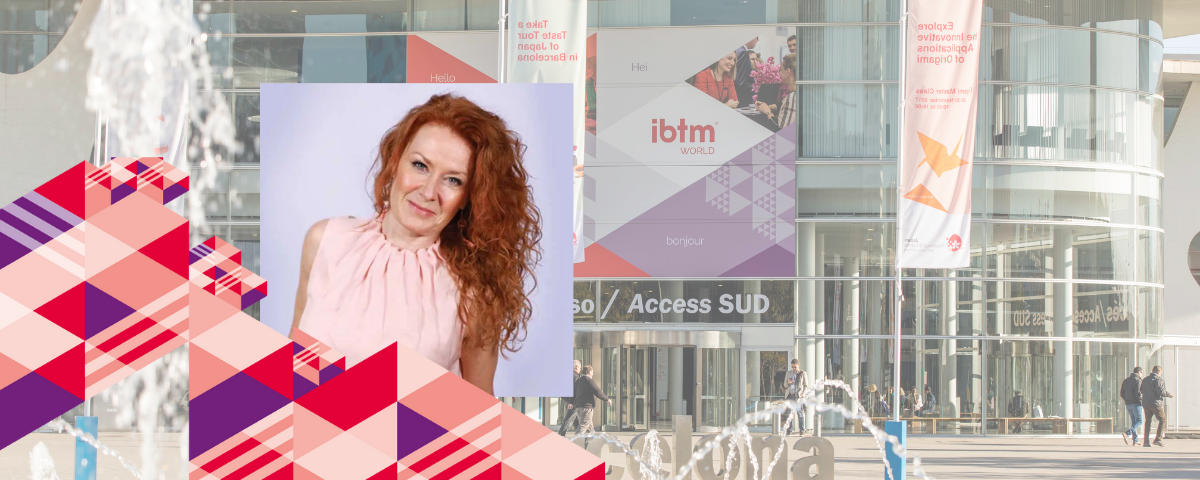This year’s IBTM World theme is “New Business, New Tech, New World” as the event has been expertly designed to provide all IBTM World attendees with the insights and knowledge they need to recover and grow in 2022 and beyond.
The sessions will take place in the Knowledge Theatre and on the Accelerate Stage and will be delivered by expert speakers from the United Nations Climate Change, LinkedIn, CrowdComms, VisitScotland, BBC Creative and more.
Majbritt Sandberg, Co-founder of RED Lab experience, which creates meeting and learning experiences in the digital and LIVE meeting space, will be speaking about ‘Re-imagine Your Online Meetings’. Majbritt is also the President of MPI Scandinavia.
We caught up with Majbritt to see how she is constantly pushing the boundaries when it comes to learning and knowledge sharing.
Q1: What are the top three technology trends you’ve seen emerging in the last two years that are impacting the world of events today?
A shift to digital platforms is the first thing that comes to mind. Online platforms have become essential tools for meeting and event organisers. Having tried most of them, I have realised it is not about the individual platform we use, but the impact it has on connecting people remotely and increasing learning.
The second trend I want to bring up are collaboration tools like Slack, Trello, Miro and Mural, which have been around for a long time, but in the last two years have become extremely popular. Productivity management, file sharing, video meetings and an ability to have your team scattered around the world, and still collaborate seamlessly, are all fantastic benefits of these tools that cannot be ignored.
Thirdly, ’omnichannel’ events, creating multiple events experiences for your audience, is an emerging trend. Omnichannel offers the unification of engagement and communication so that they complement each other – rather than run in parallel – to maximise the value of attending for participants.
It is clear that for networking, inspiration and knowledge transfer, in-person events are much more efficient, but for in-depth learning such as workshops, it makes sense to provide this online so attendees can learn at their own pace.
Q2: What have been some of the more requested tools and services by event organisers, i.e., gamification, live streaming, polling, etc.? Why do you think these have been in high demand in the post-pandemic world?
I can recommend a variety of tools and software that can be used to increase the ROI on events. Most of them have one thing in common; they help collect data on the needs and wishes of event participants. They highlight what keeps attendees up at night and reveal how we can continue to design experiences that change the way we connect, learn and interact at events and conferences.
In the last months, I have run quite a few workshops where the use of tools like Miro, Mural and Padlet have been in great demand. These are strong visual tools that are user-friendly and easy to use. You can create a link or QR code for the participants to use with their mobile phone and it requires no login. We use them for problem-solving, brainstorming, and creating digital workspaces. More importantly, we can collect insights from the participants, digitizing and creating a clear overview of discussions.
Q3: What are some of the tools/technologies you recommend to organisers when the goal is to increase pre, during and post event engagement?
For me when designing events, connecting people and creating engaging learning environments comes first. Here are examples of different tools I recommend:
- For connecting with the audience and personalizing the content pre event, using a tool like sli.do can help organisers really connect with the audience and ask them about their biggest challenges or have them address questions to the speakers beforehand. This way, you can personalise the content so it suits your audience and give speakers insights before they go on stage.
- For interactive presentations, polls and quizzes, all with a few clicks, I love using Mentimeter, which is an awesome tool when it comes to making interactive presentations – not to forget their awesome preset templates. You can include polls, quizzes, Q&As, all within the same presentation. Finally, you can collect data and insights analysis at the end of your session.
- Finally, for connecting people and creating meaningful conversations, Braindate and Twine are two examples of networking tools that work really well for post-event engagement. To keep the momentum and the energy of the live event, using networking tools is engaging and you can prolong the experience for participants and give them a little extra content and connection post event.
To read more on Majbritts’s session at IBTM World in Barcelona and to register, please click here.


